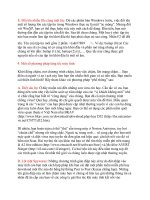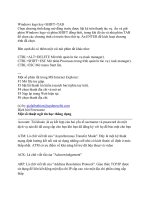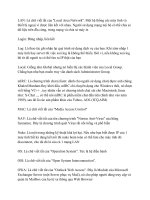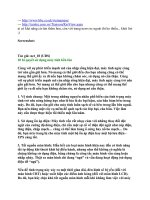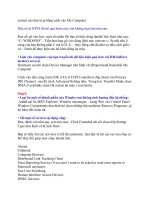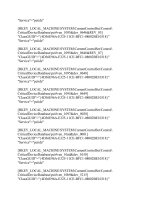Thủ Thuật Windows Office part 21 pptx
Bạn đang xem bản rút gọn của tài liệu. Xem và tải ngay bản đầy đủ của tài liệu tại đây (99.59 KB, 6 trang )
Click Start, Run và nhập vào REGEDIT sau đó đến khóa:
HKEY_LOCAL_MACHINE\SOFTWARE\Microsoft\Windows\Curr
entVersion\policies\Explorer
Tạo một giá trị mới có tên là: NoDriveTypeAutoRun
Kiểu: DWORD
Giá trị là: 0x000000b5 (181)
Bạn cần phải log off/log on hoặc khởi động lại để thay đổi có hiệu lực. Bạn cần
phải có quyền admin để thay đổi registry.
2) Để hủy bỏ CD autoplay hoàn toàn, trong Windows XP Pro
1.Click Start, Run và gõ vào GPEDIT.MSC
2. Đến Computer Configuration, Administrative Templates, System.
3. Xác định mục để tắt autoplay và sửa nó theo ý bạn.
3)Làm mất tác dụ
ng của màn hình khởi động(Splash Screen) của Windows XP
Bạn muốn biết có cái gì ở đằng sau màn hình khởi động đó? Vậy thì bây giờ bạn
có thể tìm ra!
Click chuột phải vào My Computer, Properties, Advanced, Startup and Recovery,
Settings. Biên tập BOOT.INI.
Thêm "/SOS" vào sau "/fastdetect" với một khoảng trống ở giữa. Dòng đó có thể
như thế này:
multi(0)disk(0)rdisk(0)partition(1)\WINDOWS="Microsoft Windows XP
Professional" /fastdetect /SOS.
Khi bạn kết thúc. Phần đầu tiên, multi(0) có thể không giống như trên máy của
bạn.
Khi bạn khởi động lại, màn hình khởi động(splash screen) sẽ biến mất. Nó có thể
kích hoạt lại bằng cách xóa "/SOS" đi
4) Kích hoạt tài khoản Administrator Tại màn hình chào mừng (Welcome Screen)
Cách 1: Download và cài đặt TweakUI từ gói Powertoys cho bộ Windows
XP.Trong phần Logon,
bạn có thể dấu, hoặc làm hiện ra,Các tài khoản người dùng trong màn hình chào
mừng.
Cách 2: Click Start, Run và nhậ
p vào REGEDIT, đến khóa:
HKEY_LOCAL_MACHINE\SOFTWARE\Microsoft\Windows
NT\CurrentVersion\Winlogon\SpecialAccounts\UserLis t
(nhớ là có một khoảng trống trong Windows NT).
Click chuột phải vào ô bên phải và chọn New, DWord value. Đặt tên của giá trị
giống như tên của người dùng tại màn hình chào mừng(phải khớp nhau) cho tài
khỏan bạn muốn dấu/hiện.
Double click vào giá trị mới và cho giá trị 1 để hiện tài khỏan trong màn hình chào
mừng, hoặc cho giá trị 0 để dấu tài khoản.
Ví dụ : Doug là một người dùng, Doug sẽ là tên của giá trị m
ới.
5) Kích hoạt Autologon trong Windows® XP Professional & Home Edition
Cách 1: Download và cài đặt TweakUI trong bộ Powertoys của Windows XP.
trong phần Logon,
đặt người dùng và mật khẩu mặc định sẽ được sử dụng.
Cách 2: Từ một tài khỏan Administrator, click Start, Run và nhập vào CONTROL
USERPASSWORDS2
Xóa dấu kiểm từ các User phải nhập username và password và click Apply. Làm
theo các hướng dẫn.
6)Thay đổi ký tự ổ đĩa trong Windows XP?
When you add drives to your computer, such as an extra hard drive, a CD drive, or
a storage device that corresponds to a drive,
Windows automatically assigns letters to the drives. However, this assignment
might not suit your system;
for example, you might have mapped a network drive to the same letter that
Windows assigns to a new drive.
When you want to change drive letters, follow these steps:
Right-click My Computer, and then click Manage.
Under Computer Management, click Disk Management. In the right pane, you’ll
see your drives listed.
CD-ROM drives are listed at the bottom of the pane.
Right-click the drive or device you want to change, and then click Change Drive
Letter and Paths.
Click Change, click Assign the following drive letter, click the drive letter you
want to assign, and then click OK.
You will not be able to change the boot or system drive letter in this manner.
Many MS-DOS-based and Windows-based programs make references to a specific
drive letter (for example, environment variables).
If you modify the drive letter, these programs may not function correctly.
HOW TO: Change Drive Letter Assignments in Windows XP (Q307844)
HOW TO: Change the System/Boot Drive Letter in Windows (Q223188)
XP. I do not offer ANY support for this procedure. NOTE: Some user's have
reported that this has
rendered their system unbootable. Others have reported that it works. If you follow
this procedure,
you do so at your own risk.
How do I delete an "undeletable" file?
Open a Command Prompt window and leave it open. Close all open programs.
Click Start, Run and enter TASKMGR.EXE
Go to the Processes tab and End Process on Explorer.exe. Leave Task Manager
open. Go back to the
Command Prompt window and change to the directory the AVI (or other
undeletable file) is located in.
At the command prompt type DEL where is the file you wish to delete.
Go back to Task Manager, click File, New Task and enter EXPLORER.EXE to
restart the GUI shell. Close Task Manager.
See more good Windows XP information on Kelly's Windows XP from A-Z web
site.
Editing the Registry for "other" Users
From an account with Administrator level access
1) click Start, Run and enter REGEDIT
2) In Regedit, highlight the HKEY_USERS key and go to File, Load Hive.
3) Use the File Open dialog to go to the Documents and Settings\ folder, where is
the
account you wish to modify.
4) Highlight the NTUSER.DAT file in this folder (usually a hidden file) and select
Open.
5) You'll be prompted to enter a "Key name". You can use whatever you wish, but
I use the User's logon name.
6) You can now expand the Hive you just loaded and make any needed changes.
7) When finished, highlight this Hive again and go to File, Unload Hive.
NOTE: You MUST unload the Hive prior to logging on to the users account.
Otherwise XP may have trouble loading
the user's profile.
Windows® XP - Search Problems
Windows® XP has a known issue for not finding a number of File Types when
you do a Search for



